Red rainbowfish - Glossolepis incisa
Scientific name: Glossolepis incisa
Common name: Red rainbowfish
Family: Melanotaeniidae
Usual size in fish tanks: 11 - 12 cm (4.33 - 4.72 inch)
014
Recommended pH range: 7 - 8
Recommended water hardness: 8 - 20°N (142.86 - 357.14ppm)
0°C 32°F30°C 86°F
Recommended temperature range: 22 - 27 °C (71.6 - 80.6°F)
The way how these fish reproduce: Spawning
Where the species comes from: Oceania
Temperament to its own species: peaceful
Temperament toward other fish species: peaceful
Usual place in the tank: Middle levels
General Information
The Red rainbowfish (Glossolepis incisa) is a deep-bodied rainbowfish endemic to Lake Sentani and its tributaries near Jayapura (Papua, Indonesia). It’s a shoaling, fast-swimming species that shows its best color in groups of 6 with both sexes present. Typical adult size in aquaria is ~12 cm (4.7″), with exceptional males reaching ~15 cm (5.9″). The species is currently assessed as Endangered in the wild due to habitat pressure and introduced species.
Food & Feeding
Omnivorous micro-predator. Offer a varied staple of quality flakes or small sinking granules, plus regular portions of frozen/live invertebrates (daphnia, cyclops, brine shrimp, mosquito larvae). Include some plant content (spirulina-based foods, blanched greens) to round out the diet. Feed small portions 1–2× daily; color and condition improve with variety and clean water.
Sexing
Males develop a brighter salmon-red body with a higher, deeper back and may show more intense fin color. Females are olive to yellowish and slimmer/shallower-bodied. Subordinate males can appear duller; full coloration correlates with maturity, hierarchy, and husbandry.
Breeding
G. incisa is an egg-scattering spawner that deposits adhesive eggs among fine plants or spawning mops. Condition adults well; many keepers separate a pair/group to a dedicated tank with gentle flow and fine-leaved cover. Eggs typically hatch in ~7–8 days (warmer water shortens incubation). Start fry on infusoria/liquid fry foods, then move to microworms and brine shrimp nauplii as they grow. Remove eggs or parents to prevent predation.
Lifespan
Commonly 5–8 years in captivity with stable, clean conditions; wild longevity appears lower.
Tank Requirements & Water Parameters
- Tank size & footprint: active schooling fish—aim for a long tank of 100 cm / 40″ minimum length for a group; larger is better for adult males.
- Water: tolerant in captivity; target pH ~7.0–8.0, hardness ~8–20 °dH, temperature 22–27 °C (71.6–80.6 °F). Note that wild Lake Sentani measurements are often slightly acidic (pH ~6.2–6.8) and warm (upper 20s °C); tank-bred fish adapt well to neutral–slightly alkaline water.
- Aquascape: open swimming lanes with clumps of robust plants and driftwood; moderate flow and excellent filtration. High oxygen and low nitrate are key to sustained color and condition.
- Maintenance: large, regular water changes; avoid sudden parameter swings.
Compatibility & Tank Mates
Peaceful and best in groups. Combine with similarly sized, non-nippy community fishes (other medium rainbowfishes, larger tetras/rasboras, peaceful catfishes). Avoid fin-nippers and very small or slow species that could be outcompeted at feeding time. Maintain a sex ratio (e.g., 2–3 females per male) to distribute attention.
Behaviour & Usual Place in the Tank
Active, daylight shoaler occupying the mid to upper water column. Provide floating or tall plants to offer cover without blocking surface circulation.
Conservation Note
IUCN: Endangered. Wild populations are restricted to Lake Sentani and impacted by shoreline development and non-native fishes. The species is widely available from captive-bred stocks; avoid wild-caught fish when possible.
Short Description
Red rainbowfish (Glossolepis incisa) is a large, vividly colored rainbowfish from Lake Sentani. Keep in a roomy, well-oxygenated, plant-friendly setup, feed a varied omnivorous diet, and maintain in groups for the best color and natural behavior.
Q&A
- What size do they reach? Typically ~12 cm in aquaria; large males can approach ~15 cm.
- Where are they from? Endemic to Lake Sentani (Papua, Indonesia) and its tributaries.
- How long do eggs take to hatch? About 7–8 days depending on temperature.
- Are they suitable for beginners? Yes, if you can provide a long tank, strong filtration, and stable water; they’re hardy but dislike poor water quality.
Pictures
Bought by aqua-fish.net from jjphoto.dk.
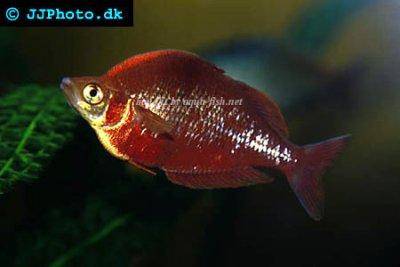




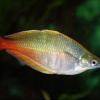 Bleher’s
Bleher’s 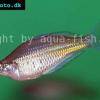 Ramu
Ramu 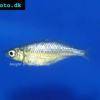 Wanam
Wanam 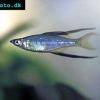 Threadfin
Threadfin 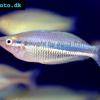 New
New 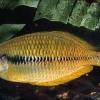 Yakati
Yakati 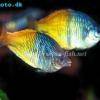 Boesemani
Boesemani 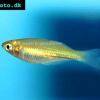 Crimson
Crimson 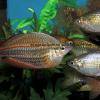 Australian
Australian 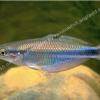 Goldie
Goldie 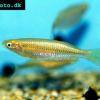 Slender
Slender 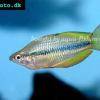 Lake
Lake 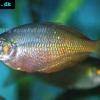 Irian
Irian 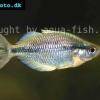 Kamaka
Kamaka 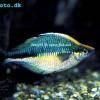 Lake
Lake 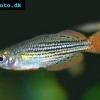 Dwarf
Dwarf 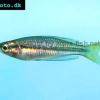 Black
Black 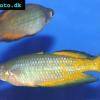 Parkinsoni
Parkinsoni 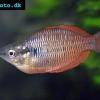 Sunset
Sunset 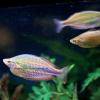 Neon
Neon 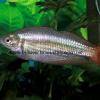 Western
Western 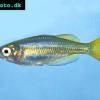 Inornate
Inornate 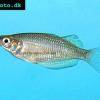 Ruby
Ruby 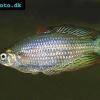 Eastern
Eastern 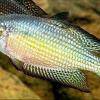 Desert
Desert 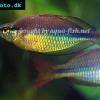 Regal
Regal